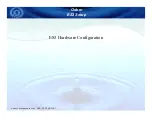
TQ Aviation
KTX2-F.0100
EASA.AP445
MAN
KTX2-F.A-MAN.0001.docx
Page 15 of 74
© TQ-Systems GmbH. All information contained in this documents have to be treated strictly confidential. The transfer of presentations and know-how to third parties
requires the prior written consent of TQ-Systems GmbH.
1.7 Features
In order to operate the Mode-S transponder it is necessary to
request an ICAO 24-Bit Aircraft Address at the responsible
National Aviation Authorities. The received code must be
configured within the transponder (see chapter 3.4.2.1.2).
•
Class 1 Level 2els Non-Diversity Mode-S-Transponder for ground based
interrogations at 1030 MHz and response at 1090 MHz
•
Replies to Secondary Radar Interrogations
o
Mode-A replies with a Squawk (one of 4096 possible Codes; e.g. flight plan
number, Squawk assigned by a Controller or the VFR Squawk).
o
Mode C replies, including encoded Flight Level.
o
Mode S replies, including Aircraft Address and Flight Level.
o
IDENT capability for activating the “Special Position Identification“- Pulse
(SPI) for 18 seconds, which is requested by the Controller “Squawk Ident”
•
ADS-B out:
o
Airborne Position
o
Identification and Category
o
Airborne Velocity
o
Operational Status
o
Extended Squitter Aircraft Status
•
Maximum flight level 30 000ft; maximum airspeed 250kt
•
Display information contains Squawk code, mode of operation and pressure
altitude
•
Temperature compensated high precision piezo-resistive pressure sensor
•
RS-232 data port enabling connection with mutual suppression and On the Ground
(weight on wheels) inputs. In addition, an appropriate GNSS receiver for ADS-B
can be connected
•
8 storable entries for AA-/Aircraft-Code, FID
•
Ground-Switch support
















































